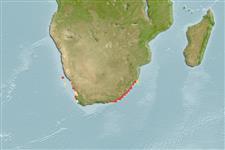Environment: milieu / climate zone / profondeur / distribution range
Écologie
marin; saumâtre démersal; profondeur 10 - ? m. Subtropical; 28°S - 34°S
Southeast Atlantic: Mossel Bay to Natal in South Africa.
Length at first maturity / Taille / Poids / Âge
Maturité: Lm 57.5 range ? - 70 cm
Max length : 200 cm TL mâle / non sexé; (Ref. 3198); common length : 100.0 cm TL mâle / non sexé; (Ref. 3507); poids max. publié: 80.0 kg (Ref. 4537)
Description synthétique
Clés d'identification | Morphologie | Morphométrie
Épines dorsales (Total) : 11; Rayons mous dorsaux (Total) : 10 - 11; Épines anales: 3; Rayons mous anaux: 8. Reddish, bronzy or golden-yellow in color; young with a blotch behind dorsal fin.
Body shape (shape guide): fusiform / normal.
Found near rocky banks in coastal waters including estuaries. Adults solitary and territorial. Feeds on octopus, crabs and fish, especially Spondyliosoma. The flesh is highly esteemed, but the liver is poisonous due to high vitamin A content which causes hypervitaminosis. Popular angling fish. Largest of the porgies.
Life cycle and mating behavior
Maturité | Reproduction | Frai | Œufs | Fécondité | Larves
Smith, J.L.B. and M.M. Smith, 1986. Sparidae. p. 580-594. In M.M. Smith and P.C. Heemstra (eds.) Smiths' sea fishes. Springer-Verlag, Berlin. (Ref. 3198)
Statut dans la liste rouge de l'IUCN (Ref. 130435: Version 2025-1)
Menace pour l'homme
Poisonous to eat (Ref. 3507)
Utilisations par l'homme
Pêcheries: intérêt commercial mineur; pêche sportive: oui
Outils
Articles particuliers
Télécharger en XML
Sources Internet
Estimates based on models
Preferred temperature (Réf.
123201): 15 - 24, mean 22.2 °C (based on 10 cells).
Phylogenetic diversity index (Réf.
82804): PD
50 = 1.0000 [Uniqueness, from 0.5 = low to 2.0 = high].
Bayesian length-weight: a=0.01549 (0.00885 - 0.02710), b=3.04 (2.89 - 3.19), in cm total length, based on LWR estimates for this species & (Sub)family-body (Ref.
93245).
Niveau trophique (Réf.
69278): 4.5 ±0.61 se; based on food items.
Generation time: 14.6 ( na - na) years. Estimated as median ln(3)/K based on 2
growth studies.
Résilience (Réf.
120179): Faible, temps minimum de doublement de population : 4,5 à 14 années (K=0.08; tm=5-7; tmax=30;).
Fishing Vulnerability (Ref.
59153): Very high vulnerability (80 of 100).
🛈
Climate Vulnerability (Ref.
125649): Very high vulnerability (92 of 100).
🛈
Nutrients (Ref.
124155): Calcium = 29 [17, 56] mg/100g; Iron = 0.833 [0.448, 1.585] mg/100g; Protein = 20.2 [19.2, 21.3] %; Omega3 = 0.36 [0.22, 0.60] g/100g; Selenium = 37.5 [16.0, 74.5] μg/100g; VitaminA = 9.94 [2.73, 33.75] μg/100g; Zinc = 0.486 [0.332, 0.711] mg/100g (wet weight);
